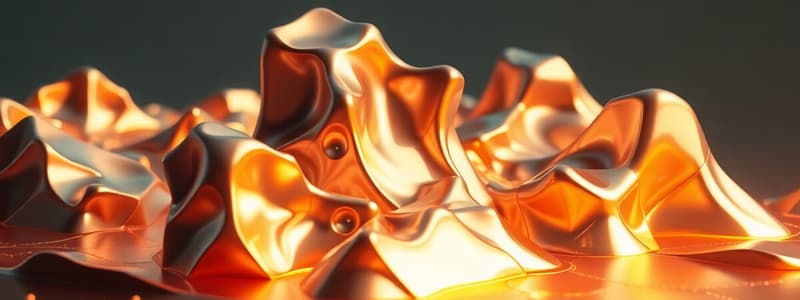Podcast
Questions and Answers
Which of the following properties is NOT characteristic of metallic solids?
Which of the following properties is NOT characteristic of metallic solids?
- Malleability
- High electrical conductivity
- Brittleness (correct)
- Luster
What does the 'sea of electrons' model in metallic bonding describe?
What does the 'sea of electrons' model in metallic bonding describe?
- Electrons are fixed in place around metal atoms.
- Metal atoms are loosely packed without any electron interaction.
- Electrons are evenly distributed within a crystal lattice.
- Electrons move freely around and between metal atoms. (correct)
In band theory, what happens as the number of metal atoms in a structure increases?
In band theory, what happens as the number of metal atoms in a structure increases?
- Malleability and ductility decrease significantly.
- The available orbitals stack closely together in energy. (correct)
- Available orbitals form a distinct gap.
- Electrons become trapped in fixed positions.
Which of the following statements accurately describes thermal conductivity in metals?
Which of the following statements accurately describes thermal conductivity in metals?
What characteristic allows metals to be drawn into wires?
What characteristic allows metals to be drawn into wires?
Which type of solid is characterized by the mutual attraction between cations and anions?
Which type of solid is characterized by the mutual attraction between cations and anions?
What is a primary characteristic of molecular solids?
What is a primary characteristic of molecular solids?
Amorphous solids differ from crystalline solids in that they:
Amorphous solids differ from crystalline solids in that they:
What holds covalent-network solids together?
What holds covalent-network solids together?
What is a common property of metallic solids?
What is a common property of metallic solids?
Which characteristic is NOT typically associated with molecular solids?
Which characteristic is NOT typically associated with molecular solids?
Which type of solid is likely to be the hardest and most brittle?
Which type of solid is likely to be the hardest and most brittle?
Under normal laboratory conditions, most elements exist as which physical state?
Under normal laboratory conditions, most elements exist as which physical state?
What is the electronic structure of graphene classified as?
What is the electronic structure of graphene classified as?
What is one of the main benefits of graphene's two-dimensional structure?
What is one of the main benefits of graphene's two-dimensional structure?
In what type of applications is graphene's heat conductivity particularly advantageous?
In what type of applications is graphene's heat conductivity particularly advantageous?
What characteristic of graphene makes it suitable for use in supercapacitors?
What characteristic of graphene makes it suitable for use in supercapacitors?
What is an application of graphene in the field of electronics?
What is an application of graphene in the field of electronics?
What challenge is associated with advancements in nanotechnology as exemplified by graphene?
What challenge is associated with advancements in nanotechnology as exemplified by graphene?
What happens to an elastomer when the stretching or bending force is removed?
What happens to an elastomer when the stretching or bending force is removed?
What is the first stage of addition polymerization?
What is the first stage of addition polymerization?
How does graphene compare to copper in terms of electrical current densities?
How does graphene compare to copper in terms of electrical current densities?
Which property best describes rubber in the context of elastomers?
Which property best describes rubber in the context of elastomers?
Which application of graphene might benefit DNA sequencing?
Which application of graphene might benefit DNA sequencing?
What distinguishes termination from the other stages of addition polymerization?
What distinguishes termination from the other stages of addition polymerization?
What does the variable 'n' indicate in the polymerization equation?
What does the variable 'n' indicate in the polymerization equation?
What has contributed to the complexity of producing polyethylene?
What has contributed to the complexity of producing polyethylene?
Why is polyethylene considered an important material?
Why is polyethylene considered an important material?
Which stage in addition polymerization follows initiation?
Which stage in addition polymerization follows initiation?
What is the degree of polymerization?
What is the degree of polymerization?
What characterizes homopolymers?
What characterizes homopolymers?
What is a key feature of condensation polymerization?
What is a key feature of condensation polymerization?
Why are polymers commonly used in engineering materials?
Why are polymers commonly used in engineering materials?
What type of polymers are typically created through addition polymerization?
What type of polymers are typically created through addition polymerization?
In chain termination, what happens to the polymer molecule?
In chain termination, what happens to the polymer molecule?
Which reaction pair is involved in condensation polymerization?
Which reaction pair is involved in condensation polymerization?
What does the molecular mass distribution in polymers reflect?
What does the molecular mass distribution in polymers reflect?
Flashcards are hidden until you start studying
Study Notes
Metallic Solids Properties
- Possess a characteristic luster (shine) when their surface is clean.
- Feel cold to the touch.
- Exhibit high electrical conductivity, facilitating easy flow of electrically charged particles.
- High electrical conductivity implies high thermal conductivity.
- Are mostly malleable (hammered into thin sheets).
- Are mostly ductile (drawn into wires).
Metallic Bonding Models
- The "sea of electrons" model offers a basic qualitative explanation.
- Band theory provides a more quantitative model, explained using the example of lithium atoms in a carbon nanotube. In a large number of atoms, available orbitals cluster closely in energy; the lower half is filled, forming the valence band.
Classification of Solids
- Metallic solids: Held together by metallic bonds.
- Ionic solids: Held together by the attraction between cations and anions; tend to be hard but brittle.
- Covalent-network solids: Held together by an extended network of covalent bonds.
- Molecular solids: Held together by weaker forces (dispersion forces, dipole-dipole interactions, hydrogen bonds); tend to be soft with low melting points.
Structure of Solids
- Many solids have repeating three-dimensional patterns.
- Amorphous solids lack ordered internal structure; particles are randomly arranged. Elastomers are an example, regaining shape after distortion unless past their elastic limit (rubber is a familiar example).
Polymer Creation: Addition Polymerization
- Monomers couple through multiple bonds.
- Initiation: Double bonds in monomers open, forming new bonds with other monomers.
- Propagation: Each monomer adds to the chain.
- Termination: Chain growth stops. Equation: n(monomer) → polymer (where n is a large number of monomers). Polyethylene is an example, with annual production exceeding 170 billion pounds.
Degree of Polymerization
- Polymer chains vary in length due to random termination.
- Degree of polymerization describes the average number of repeating units, usually calculated by mass.
Polymer Creation: Condensation Polymerization
- Monomers have two functional groups that react, releasing a small molecule (e.g., water). Example: An amine (R-NH2) and a carboxylic acid (R-COOH) react to form a bond between N and C, releasing H2O.
Polymer Types
- Homopolymers: Formed from a single type of monomer; contain one repeating unit; often made by addition polymerization.
Graphene
- A two-dimensional form of carbon, isolated from graphite.
- A semimetal with a zero energy gap.
- Electrons travel long distances without scattering.
- Can sustain high electrical current densities (six orders of magnitude higher than copper).
Graphene Applications
- Thermal: Heat sinks and dissipation films in microelectronics and larger applications.
- Energy storage: High surface area makes it suitable for batteries and supercapacitors.
- Coatings, sensors, electronics: Anti-corrosion coatings, sensors, flexible displays, solar panels, etc.
Challenges in Nanotechnology
- Innovations come with a cost (unspecified).
Studying That Suits You
Use AI to generate personalized quizzes and flashcards to suit your learning preferences.




